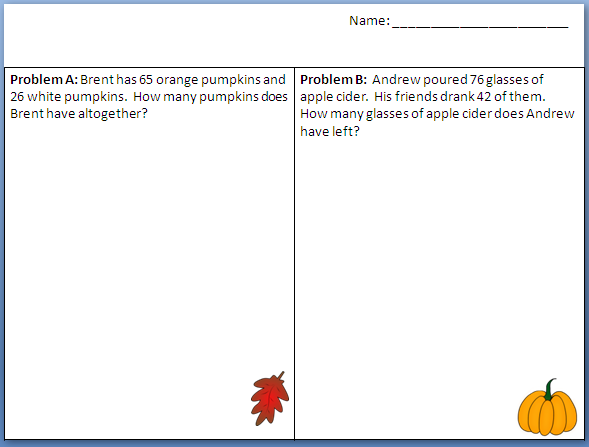I finally got my 0-120 place value deck in finished form. If you missed my last post about some of the ways I use this deck in the classroom, click here to check it out or here to see what each deck looks like! Want a set of these cards for your classroom? Head to TPT for the full product and a free preview!
1 More or Less AND 10 More or Less
By the end of grade 1 kids should be able to mentally find 1 more or less and 10 more or less than any number under 100. I often find this is a skill that needs to be revisited at the beginning of second grade as well because it REALLY supports adding and subtracting 2 and 3 digit numbers.
I often have kids make their own record sheet for this because it is simple and straightforward. I start with 1 less and 1 more in Kindergarten. I might start with just the cards up to 10 and as individual kids become fluent, I give them more challenging cards. The visual images on the cards really support kids thinking about 1 more/less or 10 more/less because they can cover up a piece or think of adding another piece. Using these cards leads to a mental image that kids can access whenever they need to. You will know your students have met the standard when they can use deck C and flip through and fluently identify 10 more or less than any number under 100.
Second graders need to be able to do the same thing but by the end of the year need to be able to identify 1 more/less and 10 more/less up to 1000. If your students come in to second grade not able to fluently do this up to 100, than you will want to start here! If you do work with second or up you also might want to check out my numbers to 1000 place value deck.
Close to 100
This is a game I introduce toward the end of grade 1 and play a lot the last month. I also bring this game out again at the beginning of second grade because it relates so many ideas of place value and addition and subtraction of 2 and 3 digit numbers.
This is another game where I have kids make their own record sheets. They simply flip over 2 cards and find the sum. Their partner does the same and the winner is the person who is closest to 100 (under or over). The winner of each round circles their sum to indicate they won (see picture on left). Another variation is to have students figure out and record exactly how far away from 100 they were (see picture on right). Students often use a 100’s chart or a base 10 hundred grid when starting out with this game for support in finding distance from 100. The visual images on deck A or B really support students who struggle with 2 digit addition.
Pairs to Make 100
 |
| Make 100 Concentration Game. Get it for your students! |
Many programs deal with pairs to make 10 in a big way in Kindergarten and first grade which is great. However, as important as pairs that make 10 can be for addition and subtraction facts, pairs that make 100 can be just as powerful when kids are exploring multi digit addition and subtraction in 1st and 2nd grade. Here are 2 ways I use these cards to work on this BIG idea. Click here to see other ways I help kids with pairs that make 100
Make 100 concentration
I play this like a classic memory or concentration game. A “match” is found when 2 cards add to 100. You do have to go through your deck and find pairs that make 100 before giving kids this game to play. I do this on occasion and other times have kids find pairs that make 100 and make mini-decks from there. Any of the decks work great for this gameMake 100 Pair Match
As kids are coming into the room or transitioning between activities, I often use this game. I preselect pairs that make 100 and mix them up. I hand each student a card and it is their task to find a person whose card goes with theirs to make 100. |
| Make 100 Pair Match |
Multi-Digit Addition and Subtraction
In first and second grade multi-digit addition and subtraction becomes very important. I will often hand each kid 2 cards and have them find the sum or difference between the cards. This can be done during transition times or as an exit ticket or kids can make a simple record sheet and play a game. It also works quite well as a compare/war game where they flip 2 cards, find the sum or difference and the winner is the person with the largest answer.
Click here to see some of the strategies my students have invented for multi-digit computation

How would you use this deck in your classroom?























